Branches of coral are cut out into short cylinders, which are grinded then polished
in shape of balls (pearls) of various sizes. At least for the best quality.
Red Coral of the Mediterranean.
The red coral branches are nowdays of small diameter because, at a rate of 6 to 8 cm per annum, its exploitation does not allow a
grow sufficient in spite of banned marine zones for seven years (Corsica).
Only seldom beautiful branches allow to polish large pearls for the top prices.
Installed thirty years ago in the Mediterranean towards 30 to 50 meters, in Corsica, high place of the world coral, it is necessary to go to seek
it from now on within 100 meters deep. Relatively little fishermen end their life normally, because it takes 2 hours 30 of
decompression under water on several levels for only 15 mn of diving.
Small robots are being studied to go and locate it, which would avoid the seeking divings which represent of 60 à.70.% of the activity.
One of these robots is worth 21.300 €.
|
A good quality is worth 53 € the gram, that is to say approximately twice that of gold.
A beautiful
 branch of one kilo can reach 15.000 € (2005), but one kilo of small branches (of about fifteen centimetres), is worth "only" 1000 €.
The
matter loss is significant for the first choice: of one kilo, there will hardly remain but 10 grams of pearls ! but I suppose this is only true for
the best pieces, because he is sold bracelets or collars made up of secondary choice, even popular, hardly cut or not at all, which have nothing
to do with the collar at 25.360 € or the Thirty year bracelet at 3400 €.
Thalassa, TV FR3. Oct. 2005.
branch of one kilo can reach 15.000 € (2005), but one kilo of small branches (of about fifteen centimetres), is worth "only" 1000 €.
The
matter loss is significant for the first choice: of one kilo, there will hardly remain but 10 grams of pearls ! but I suppose this is only true for
the best pieces, because he is sold bracelets or collars made up of secondary choice, even popular, hardly cut or not at all, which have nothing
to do with the collar at 25.360 € or the Thirty year bracelet at 3400 €.
Thalassa, TV FR3. Oct. 2005.
|
Red coral and ancient people.
Egyptians, Greeks, Romans used the coral red for manufacturing jewellery and various objects.
The Christian religion has raised this colour as the symbol of the blood of the Christ.
They also thaught it had magical powers : to defeat the evil spell, ensuring the earth's fertility, protect crops from
hail, or vessels from lightning, even to keep the hatred away. In the Middle Ages, one dropped chunk of coral in a scholarship to make talismans against
witches. At the same time, he was reduced to powder in the boiled of babies because it was supposed to protect them against epidemics.
|
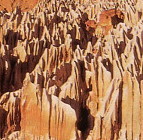
|
Madagascar, preserved bus detached from the African continent, present many characteristics, as well by its fauna, its flora as its geology.
Its "exclusive" baobab trees (endemic), are very famous there.
Here something of less known, its "geological" corals. Enough deep to form small narrow canyons, scientists goes down there sometimes researching some rare species.
|
Numerous mountains are marine deposits (limestones) pushed up, at least for the external layer.
Coral reefs do not have escaped from this movement, as in Madagascar ; it is also the case for the Dolomites (Italy).
Canyons of Madagascar are however more spectacular.
|
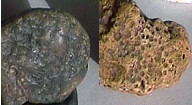
|
Two exemples of fossil corals : on the left part of the picture, coral foot print preserved in
a silex.
On the right part, it is a true
fossil coral
(Noumea).
|
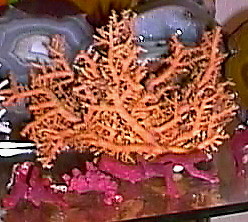
Yellow coral branches and chunks of red corail, at the bas of the picture.
|
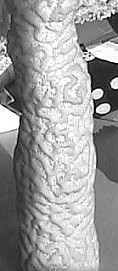 On the left hand, a small convolutions coral (brain), column shaped.
On the left hand, a small convolutions coral (brain), column shaped.
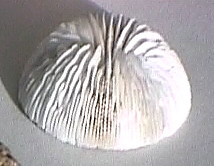
Above, a five centimetres "lonely" coral.
|
Surgerie
The coral is worth gold : its medical cost is very high. But results are up too.
over a decade, the coral has a medical use, particularly in the field of reconstructive surgery of the face.
More significant prostheses (members), are also concerned because the coral proved to be nearly like bone.
According to what I understood, the coral help the osseous system to be
reconstituted, bone substituting or gradually covering the coral which would be used as reinforcement ; it would thus not replace directly and definitively the bone.
Under all concerning its mode of action and use, it would allow reconstituting indirectly bad or broken bones, giving again life to a damaged jaw or face.
|
Research. Producing coral of great quality (Very hard).
Both corals variety and complexity of construction intrigue us and scientists are interested
in ; the central part of their skeletons is sometimes very hard and makes think at our reinforced concrete.
In the laboratory of the Monaco oceanographical museum, one makes grow
coral branches hooked inside containers reconstituting the natural sea water, while in the aquarium of Nouméa, one succeeded in carrying out the reproduction of corals.
At Vanuatu and elsewhere now, they resows corals starting from fragments laid out on the sea-bed.
Will it be produced artificially one day, quickly and in large amount ?
it is the eternal hope of the man in front of nature mysteries which he would like to synthesize.
|

 surprising oceanic life, nautile, fish, fishing, dugouts, sea snake, reefs and passes..
surprising oceanic life, nautile, fish, fishing, dugouts, sea snake, reefs and passes..







On the left hand, a small convolutions coral (brain), column shaped.
![]()
![]()
